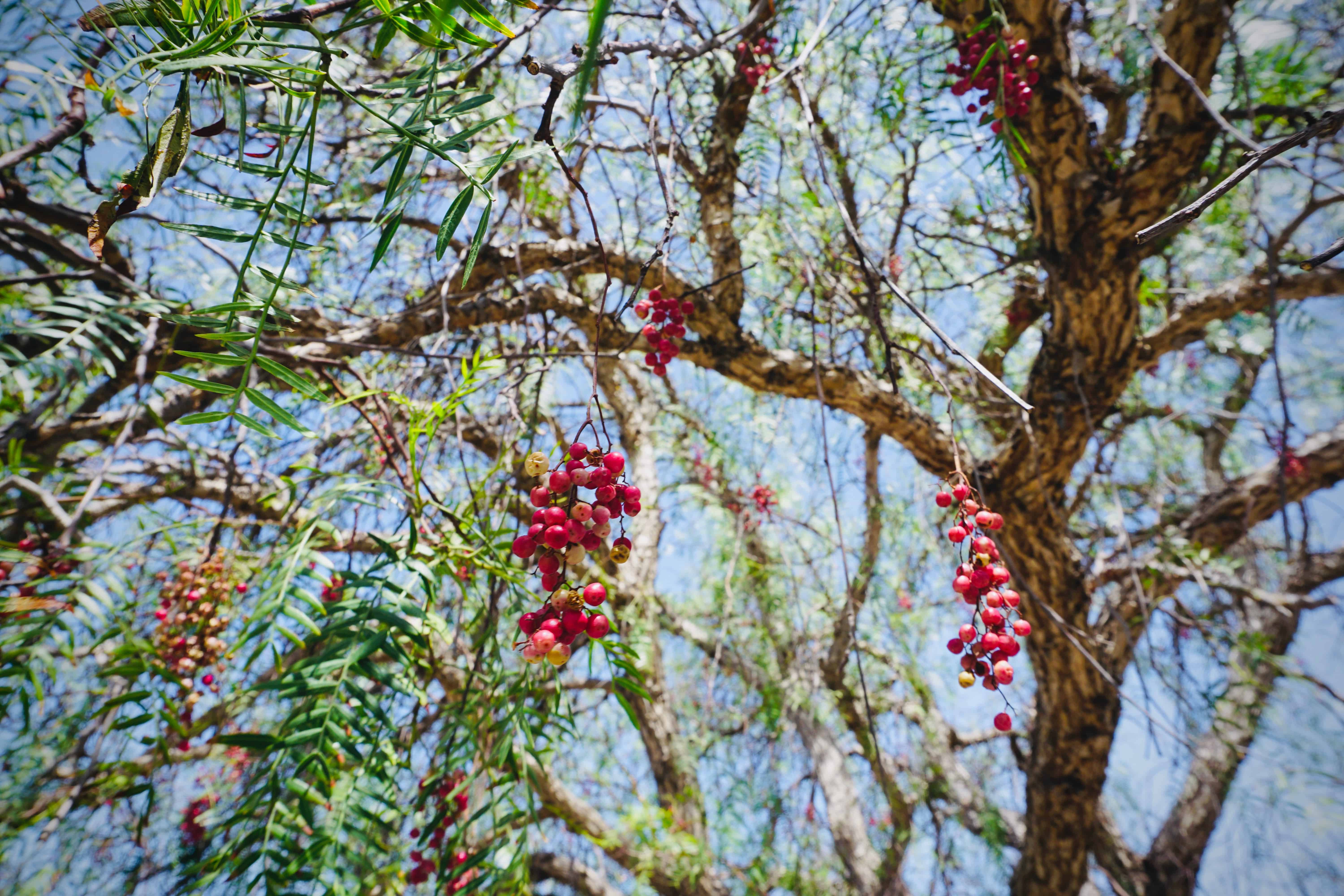The “pink peppercorn tree” refers to the Schinus molle tree, also known as the Peruvian peppertree or California pepper tree. Despite its name, it is not closely related to the true black peppercorn plant from which black pepper is derived. The pink peppercorn tree is native to South America and is known for its attractive appearance and aromatic berries.
In that regard, as we’ll see below the commercial uses for the wood produced are relatively limited and the berries produced are really the popular and valuable part of the tree.
Characteristics of the Pink Peppercorn Tree
- Appearance: The pink peppercorn tree is a small to medium-sized evergreen tree with feathery, fern-like leaves. It has a graceful, weeping growth habit and a distinctive reddish-brown bark.
- Berries: The tree produces small, round berries that start green and turn shades of pink, red, or purplish as they ripen. These berries are often used as a spice.
- Flavor: The pink peppercorns have a mild, slightly sweet, and fruity flavor with a hint of spiciness, similar to but milder than true black peppercorns.
- Uses: The berries are used as a spice, particularly in gourmet cuisine. They are sometimes included in spice blends, sauces, and as a garnish for their unique color and flavor.
- Culinary Applications: Pink peppercorns can be used in both sweet and savory dishes. They add a pop of color and mild spiciness to salads, meats, seafood, and even desserts.
- Caution: It’s worth noting that while pink peppercorns are generally safe for consumption, some people may experience allergic reactions or skin sensitivities. They are not recommended for individuals with allergies to cashews or pistachios due to potential cross-reactivity.
Cultivation and Growing Conditions
- Climate: Pink peppercorn trees thrive in warm and subtropical climates. They are often found in regions with mild winters and hot, dry summers.
- Soil: They prefer well-draining soil and can tolerate a variety of soil types, including sandy or rocky soils.
- Care: Pink peppercorn trees are relatively low-maintenance. They are drought-tolerant once established and can be grown from seeds or cuttings.
- Invasive Potential: In some regions, the pink peppercorn tree is considered invasive and has the potential to outcompete native species.
Culinary and Decorative Use
- Pink peppercorns are known for their vibrant color, making them popular for garnishing dishes, especially in fine dining.
- They are used to impart a delicate peppery flavor to foods without overwhelming the palate.
- Pink peppercorns can be included in various spice blends, sauces, marinades, and even cocktails for a unique twist.
In summary, the pink peppercorn tree, with its attractive appearance and mild peppery berries, offers both culinary and decorative benefits. It’s important to use them in moderation and be mindful of any potential allergies or sensitivities.
Commercial Uses For Pink Peppercorn Is Limited
Pink peppercorn wood is not commonly used for woodworking or other practical purposes. While the pink peppercorn tree (Schinus molle) is valued for its culinary use and ornamental qualities, its wood is generally not utilized in the same way as other hardwoods. The tree is more known for its pink berries, which are used as a spice and flavoring in various dishes.
The wood of the pink peppercorn tree is not widely considered for commercial applications due to its small size, irregular growth patterns, and lack of desirable characteristics for woodworking. As a result, pink peppercorn wood is not a common material used in woodworking projects.
Pink Peppercorn Trees And Wood Characteristics
Here is a table summarizing the characteristics of Pink Peppercorn trees and wood. As we’ll see, the wood itself isn’t as useful as other woods and many aspects that we normally discuss on this website aren’t particularly relevant in this case:
| Category | Characteristic |
|---|---|
| Scientific Name | Schinus molle |
| Common Names | Pink Peppercorn Tree, Peruvian Peppertree, California Pepper Tree |
| Family | Anacardiaceae |
| Origin | South America |
| Tree Height | Up to 40 feet (12 meters) |
| Wood Color | Typically not used for lumber |
| Wood Grain | Not applicable |
| Density | Not applicable |
| Durability | Not applicable |
| Workability | Not applicable |
| Uses | Culinary spice, garnish, spice blends, sauces, decoration |
| Resistance | Not applicable |
| Finishing | Not applicable |
| Sustainability | Not applicable |
| Availability | Widely cultivated, but wood not commonly used |
Please note that the pink peppercorn tree is primarily valued for its culinary use (berries) and aesthetic appeal rather than its wood, which is not typically used for lumber or woodworking purposes.

